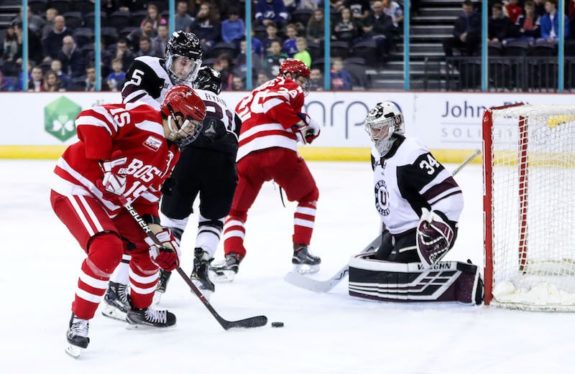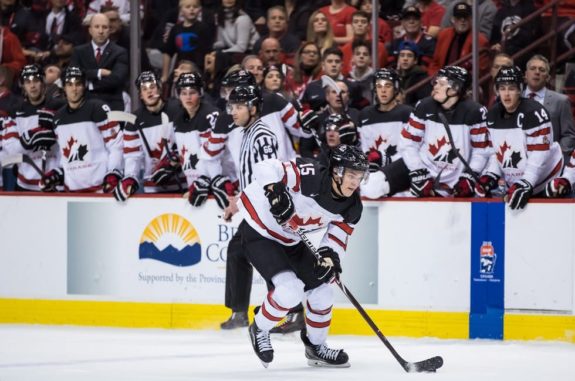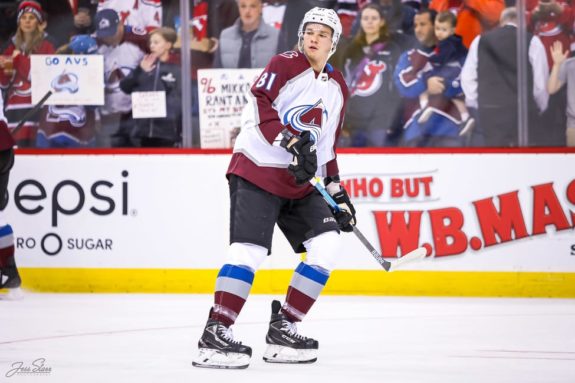A couple of months ago, when I wrote that the Colorado Avalanche farm system is weak down the middle, I didn’t mean it as a slight on Shane Bowers. He successfully made the switch to left-wing last fall in the AHL at the encouragement of Colorado Eagles’ head coach Greg Cronin. Bowers’ development on the wing has paid off, having been named to the 2020 Avalanche playoff roster. Bowers appears likely to earn an Avalanche roster spot out of camp next season as an encore, and I think his long-term position in the NHL is on the left side.
Related: What Joe Sakic Means to the Avalanche
Originally drafted by the Ottawa Senators in the 2017 Draft at No. 28 overall, Bowers found his way to Colorado through the three-team trade that sent Matt Duchene to Nashville in November 2017. Bowers was drafted as a center and began his career in the Avalanche organization as one.
Busting Out for BU
He ended his freshman season in 2017-18 with the Boston University Terriers ranked fifth in scoring for U-20 skaters in the NCAA (17 goals and 15 assists for 32 points in 40 games). Third on the team in scoring, he more than doubled teammate Brady Tkachuk in goals (he had eight). Bowers had the top plus-minus for a forward that season NCAA-wide and was one of only five forwards to place in the top 15. That was a promising aspect of Bowers’ performance and lent credence to projecting him as a two-way forward in the NHL.
Not to excuse his severe drop in output in 2018-19, but Bowers and his teammates experienced a sudden coaching change before the season. BU also graduated several players to the professional ranks (like Tkachuk). Clearly the Avalanche didn’t put much weight in his down season either, because the organization signed Bowers to an entry-level contract in March 2019 (three years, $2,775,000).

Bowers found himself in the AHL for four games after his sophomore season in college. The 2019-20 season was his first full season in the minors and he improved dramatically over time. Bowers told Ryan S. Clark in a January 2020 post on The Athletic that he credited his familiarity with the Eagles as being the reason why he predicted he’d develop well this season:
Obviously there was a little bit of an adjustment period, coming from college to here. Just getting here, not knowing the guys, not feeling as comfortable as I was; to now coming back here, I’ve had a full summer under my belt and kind of knowing what things are like. I’m definitely feeling more comfortable and I’m ready for it.
From ‘What’s changed with Avs prospect Shane Bowers lately? Well … everything’, The AthleticNHL – 1/24/2020.
The Avalanche’s top center prospect was starting his first full professional season seven months after signing with the club. There was a lot of anticipation for Bowers given his pedigree, and a lot of hope that he could make the jump from college to the Avs’ top minor league affiliate.
Change is Needed
However, Bowers started the season in a seven-game point drought. Also, his inexperience in the defensive zone was getting exposed. As a result, Cronin moved him to the wing where defensive responsibilities aren’t as robust. Cronin also spoke to Clark and explained Bowers’ position move to LW:
“He got moved to wing. He’s a natural centerman but we found out there was a lot of pressure on him down low and he had some poor habits that were translating into giving up chances against. We just felt that if we just let him manage less space…by having him as a wing, it would let him get his confidence back and his offense would start to grow from that and that’s what happened.”
The move paid off. In the time between when his drought ended on Nov. 1 and the date of the aforementioned Cronin interview (Jan. 24), Bowers scored 18 points in 23 games. From Dec. 7 to Jan. 17, he scored as many points as he played in games (14). Bowers went from overmatched AHL rookie to rising star in two months.

There are draft analysts that project Bowers as a top six, two-way forward. The more he learns the left-wing role in the minors, the more he’ll play that position in the majors. The NHL isn’t the place to start learning how to become a professional center; that’s for what the minors are. He may be able to pitch in at center if need be, but his chances of succeeding in the big leagues greatly increase if he stays on the wing.
Eyed for the Fourth Line?
Over the next two seasons, Bowers will have ample opportunity to log major minutes with the Avalanche. The club is likely to lose four wingers after this season to free agency: Vlad Namestnikov, Colin Wilson, Matt Nieto, and Vlad Kamenev. Also, Tyson Jost and Val Nichushkin are restricted free agents and both may not receive multi-year deals.
Related: 2013 NHL Draft – Where Are They Now?
I think it’s more likely that the Avs replace Namestnikov through free agency or go with the in-house choice of Matt Calvert than giving the third-line LW role to Bowers right out of training camp. After next season, the club may lose the other two fourth-liners to free agency, Calvert and Bellemare. If Jost isn’t locked up long-term or underwhelms next season, he may get exposed to the Seattle Expansion Draft.
Slotting Bowers on the fourth line in Nieto’s position will accomplish several things. It’ll take the pressure off the young talent to immediately contribute offensively and give him ample opportunity to develop his two-way game. Simultaneously, fighting for a promotion to one of the three scoring lines will motivate him to shine. Building his confidence will have a huge impact on his early development. I don’t think using Bowers as the 13th man in place of Kamenev will develop him better than keeping him for another full-time season in the AHL. Prospects need minutes to grow.

Another thing to keep in mind is that Avs head coach Jared Bednar doesn’t stock his fourth line with bruisers just to set a physical tone; he’s much more strategic than that. In an interview with Zach Shapiro of the Avalanche’s official site, Pierre-Eduoard Bellemare, who centers the line with Nieto and Calvert, spoke about how the Avs’ fourth line is special:
There is not a shift where those guys are going to be satisfied to just play a checking shift. They are going to want to create, want to produce, try to create momentum. So that’s maybe one of the biggest differences with some of the lines I’ve played with before is that we’ve been known to be just a solid checking line against the top line and be, you know, physical and everything. But, with Nietsy and Calvy, I feel like we are creating more offense than people are expecting from us.”
Developing the two-way game of a prospect of Bowers’ caliber on the fourth line isn’t so outlandish when knowing what the team expects from the line. Breaking up the chemistry with Nieto will probably lead to some early bumps in the road, but the praise for Bowers at every stop has involved how studious he is about the game. He’ll play with two experienced two-way veterans from whom he can soak up knowledge. Bowers may even see time on the penalty-kill with Bellemare if he can handle the fourth-line duties well.
Future Opportunities in Denver
Like fellow ex-Terrier Nieto, Bowers is very poised with the puck with guys draped all over him. They’re high motor players with good skating skill and agile sticks. Bowers has the bigger frame and is a better passer, and he could fit in with Calvert and Bellemare just as well as the man he’ll replace.
Related: Roger Neilson – Coaching Genius & Innovator
The 2020-21 season may bring center prospect Alex Newhook to Denver full-time. A natural goal-scorer, Newhook would play very well with the slick-passing Bowers on his wing. This pairing is the kind of young, homegrown talent that is central to the front office’s mission. It’s going to be very exciting seeing these players develop and fight for Stanley Cup championships together.